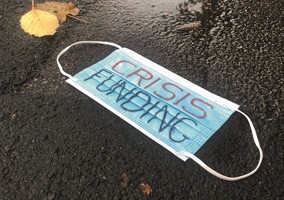As we hurtle towards the end of the year, there has been a flurry of reports, publications and surveys about the impact of the pandemic on the charity sector.
This means that we’re now in a position to paint a much more detailed picture about how both individual charities and the sector as a whole have fared over the past 18 months, and importantly, what challenges they are likely to face in the months ahead.
That is not to say this picture is always easy to interpret. Too many numbers can be overwhelming at times, and some of the evidence can seem contradictory.
Things were bad, really bad
Firstly, and this won’t be a surprise to many, the pandemic has had a negative impact on almost every charity.
Academics from the Third Sector Research Centre (TSRC) analysed nearly 50,000 charity accounts covering the early months of the pandemic. They found that the typical charity lost 15% of its income and a least a quarter of charities lost more than 40% of their income.
Worryingly, TSRC concluded that the pandemic was already having a “much more sizeable” effect on charity finances than the recession that followed the banking crisis in 2008-09.
Elsewhere, polling conducted for the Charity Commission found that more than 90% of charities were negatively affected by the coronavirus crisis. A total of 60% said their income had fallen, while 57% were forced to cancel events or planned work.
Other surveys, such as one carried out by Pro Bono Economics, highlighted the challenge created by rising demand, especially at a time when raising money became more challenging.
But not as bad as it could have been
The government claims its support for the sector amounted to billions.
This is probably true. There were a variety of targeted grant and loan schemes to help parts of the sector. The best-known of these was the £750m grants package for charities, which was at times criticised for being distributed slowly.
Another important source of support was the furlough scheme, where the government paid a portion of the wages for people who were unable to work during the pandemic.
Various charities have described the furlough scheme as a lifeline. For those parts of the sector that were barred from opening their doors, it was a sensible and effective scheme.
Indeed, as large charities started to file their accounts, it became noticeable that their finances were healthier than first projected, often due to the amount they had claimed in furlough.
For example, English Heritage reported that it made nobody redundant as a result of the pandemic, but it did use the furlough scheme for almost 90% of its staff.
Fundraising has also been a source of optimism. According to the latest UK Giving 2021 report, produced by the Charities Aid Foundation (CAF), the total amount donated to charity actually increased slightly to £11.3bn in 2020, despite the challenges with in-person fundraising.
Daniel Fluskey, head of policy at the Charted Institute of Fundraising, said this was testament to public generosity and the “tremendous efforts of fundraisers” in devising new, virtual ways to raise money.
Pressures on fundraising
However, CAF’s report was not all good news for fundraisers. It highlighted that, although more money was donated, fewer people were giving.
However, this trend pre-dates the pandemic, and suggests some systemic issues with the current fundraising model.
Furthermore, predicted cost of living increases, such as escalating heating prices, will likely reduce many people’s ability to give.
A survey carried out by the Big Give, an initiative which runs a large coordinated fundraising appeal at Christmas, found that one quarter of respondents were planning to donate less to charity this year, compared with 10.8% who plan to give more. Most (46.9%) plan to give the same amount, and the rest either don’t know or never give.
Demand pressures
Those government initiatives, which acted as a cushion to soften the blow of the pandemic, have largely run their course.
Some ongoing measures, such as the extension of the museums and galleries exhibition tax relief will help. But the government has been clear that another large-scale funding package is not on the cards.
In practice, this means some charities will face a very challenging 2022, with less access to support.
There have been widespread reports that demand for a variety of charity services has risen during the pandemic, and, with increasing pressures on household incomes, this looks set to continue.
Just in the last few days, Shelter has warned that since the Covid restrictions began to lift, more than 1,000 callers a day have contacted its emergency helpline in England.
Similarly, the NSPCC has said reports from people concerned a child is being, or has been, sexually exploited and/or abused, have risen 36% in the first six months of 2021-22 when compared to the same six months of the previous year.
What we don’t know
Finally, we’ll probably never be able to get a handle on the true cost of some charities effectively hibernating when they could have been preparing for surges in demand or innovating new fundraising models.
Essentially the government support during the pandemic was in line with broader policy and was about protecting existing jobs and dealing with the immediate challenges, not preparing for the future.
It has often been observed that the pandemic exacerbated inequalities, and the charity sector is no exception. Different subsectors have always attracted different levels of support, and a widely reported boost to giving in the early days of the pandemic was strongly correlated to support for NHS charities, and not sustained across the wider sector in the long term.
At the same time, the furlough scheme was not as much help to smaller charities, which form the bulk of the sector and employ no, or very few, staff.
Charities that were able to take full advantage of government schemes, mothball themselves, and pop back up when restrictions eased, may well be in a positive position.
However, the evidence so far suggests those are the minority. Many may have got through 2021 in better shape than first feared, but still face an uphill battle to raise enough funds to meet increasing challenges.
Related articles












